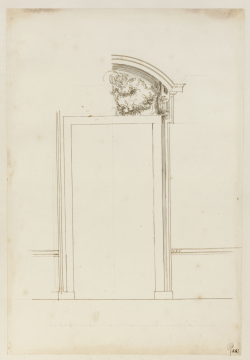Explore Collections


You are here:
CollectionsOnline
/
[2] Design for a doorcase with a segmental pediment on angled consoles and a combined tympanum and frieze with swags of fruit and flower, possibly for the King's Bedchamber
Browse
Reference number
SM, volume 110/55
Purpose
[2] Design for a doorcase with a segmental pediment on angled consoles and a combined tympanum and frieze with swags of fruit and flower, possibly for the King's Bedchamber
Aspect
Elevation, incomplete on left
Scale
Drawn scale: 1 foot to just under 1 inch, or 24.5mm (4 feet to 3 15/16 inch)
Inscribed
In ink by George Dance at bottom right, Gd, and to right by a C19 hand, (54), altered from 55.
Signed and dated
- Undated, but probably c.1693-94
Medium and dimensions
Pen and brown ink over graphite under-drawing, with warm grey wash and some additions in graphite, including scale bar; on laid paper; two small areas of pinkish-brown staining at top of sheet; 428 x 290
Hand
Gibbons
Watermark
Countermark: CDG
Notes
The design is to the same scale as the other four in this group (110/54, 56, 57), and the door opening is the same size as 1, above (110/57). As the King's Bedchamber is the only room in the suite of apartments with 4-feet-wide door openings, it could either be an alternative for 110/57, or a design for the doorcase to the opening at the rear of the room, connecting with the Gallery (used by William as a Council Chamber). The height of the dado rail is the same as for 110/54 and 57. Only the King's Bedchamber had 4-feet-wide door openings and dado rails 2 feet 6 inches high.The design has a similar canted console to that on 110/54. The spatial relationship between the door frame and outer architrave is the same as on 110/57. However, the door frame and overall frame width architrave are both narrower on this design (5 inches and 9 ½ inches compared with 6 ½ and 11 inches) and the door surround is also simpler than 110/57. This could indicate that it was intended for the less prominent rear door opening. The scale bar divisions are like those on 110/66, that is, a foot divided into quarters, with a longer stroke on the half division.
Literature
Wren Society, IV, pl. 41, top right
Level
Drawing
Digitisation of the Drawings Collection has been made possible through the generosity of the Leon Levy Foundation
If you have any further information about this object, please contact us: drawings@soane.org.uk

